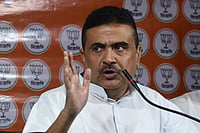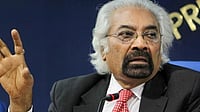WHEN P. Chidambaram promised in his Budget speech a discussion paper on all subsidies—visible and hidden—he blazed a trail in a vast, unch-arted and confused territory. Barring the Andhra Pradesh Government's recent move to lay bare its financial skeletons before the public, neither the Centre nor the states have tried to harness this white elephant. Subsidies have always been considered a necessary evil, to ostensibly keep the poor happy and serve broad social and economic goals (read: protecting the vote bank).
Total subsidies, as named and acknowledged by the Government, zoomed from Rs 5,980 crore in 1987-88 to Rs 16,320 crore in the current Budget, rising by an average of 16 per cent every year. As a percentage of GDP though, it has hovered between 1.2 and 2.2 per cent, and of late, shown a declining trend (the Budget tries some resurrection). These include mainly the much-maligned subsidies on food and fertiliser, and on export promotion. But what many feel has reached alarming proportions, skewing the entire culture of public spending and threatening a major fiscal disruption, is the amount of hidden, and therefore unquantified, subsidies at multiple levels—differential pricing, social welfare schemes, loan waivers, protection to economic sectors, and cost of draconian inefficiencies. Says Pranab Sen, senior consultant, Planning Commission: "Even the Government, Central or state, doesn't know how much subsidy it's giving and where."
There have been few expert efforts to quantify subsidies. A pioneering study by Sudipto Mundle and M. Govinda Rao of the National Institute of Public Finance and Policy (NIPFP) in 1990-91, which went into the volume and composition of subsidies given by the Centre and 14 major states, found that total subsidies, nominal and hidden, rose from about Rs 8,000 crore in 1977-78 to over Rs 44,000 crore in 1987-88, or from 8.2 per cent of the GDP to over 15 per cent. A recent extension of the study by A.C. Tiwari, senior consultant to the Indian Council for Research on International Economic Relations (ICRIER), finds that the amount shot up to Rs 95,373 crore in 1992-93, though its share in the GDP remained stagnant at 15.2 per cent.
Many of the explicit subsidies were started to help income redistribution and correct skewed development, but over time, as the government went into more and more sectors of the economy, its expenditure ballooned. As fiscal imbalance grew, along with the need for huge resources, a few questions came to be asked increasingly: Are all these subsidies necessary? Are these going to those who really deserve it?
Well, no. Neither are huge outgos on subsidies justified, nor are they being targeted properly. Let's take explicit subsidies first. Central food subsidy tripled from Rs 2,000 crore in '87-88 to Rs 5,884 crore in the current Budget, while total fertiliser subsidy rose almost four times to Rs 8,372 crore. The former is given to meet the cost of stock holding by the Food Corporation of India (FCI)—in itself a factor of many inefficienc-ies—and to provide grain through fair price shops (FPS) cheaper than the cost of procurement. Maintaining this high-cost operation can be questioned on two grounds:for one, profit potential from the difference between the FPS price and market prices diverts cheap grain to the open market, negating the rationale for subsidies. For another, the number of beneficiaries is too small. If 90 per cent of us were ration-card holders, 45-50 million tonnes of food grain would have been needed to feed the PDS. But the current off take is a paltry 15-16 mt. Nor can we afford the huge subsidy that would be required if all of us were to actually lift the quotas of grain and sugar. Secondly, regional off take figures show that the poor are largely out of the realm of the PDS. Off-take is higher in urban areas than in villages, and the poorest areas of Bihar, Madhya Pradesh and Orissa have the lowest offtake. Perhaps 85 per cent of the food subsidy bill will vanish if the FCI is done away with.
Much of the fertiliser subsidy, on the other hand, is a cross-subsidy—a compensation for the high-operation costs of public sector fertiliser plants. Worse, there is a double subsidy involved, as fertiliser plants get subsidised feedstock—naptha and urea. Unfortunately, like food, the fertiliser subsidy is also a strategic subsidy. And it does benefit farmers—poor or rich—as without a subsidy, many of them simply can't afford it. "We subsidise the plants because we don't want to depend on global supplies. But cross-subsidy is in effect a tax on farmers," says Sen. The case against the major subsidies is, therefore, more a case for rationalisation, efficient targeting and gradual phaseout of cross-subsidy. Says Shashank Bhide, chief economist, National Council of Applied Economic Research: "Cross-subsidisation must go over time. So should subsidising through price manipulation." In the petrogoods sector, for instance, a comprehensive price reform plan is on the back burner and the oil pool deficit—the difference between the cost of production or import of the products and the sale price—keeps growing.
The third key subsidy, on export promotion and market development, dropped steadily to Rs 315 crore last year as most export sops have been scrapped with only duty drawback and refund of terminal excise continuing. This Budget has raised export subsidy by 48 per cent, perhaps rightly. After all, even the US gives export subsidies. The Centre continues to cross-subsidise the Railways via dividend concessions, the public sector in terms of interest concessions on government loans, sharply up in this Budget, and the Department of Posts' deficit, up three times since '87-88.
Explicit subsidies are just the tip of the iceberg. A much higher government largesse goes to the better-off and vested interests through widespread hidden subsidies ( see chart ), which were a whopping 78 per cent of the total in '92-93. Says Subhashis Gan-gopadhyay, economist, ISI: "The ideal way to look at subsidies would be to look away from the obvious culprits—food, fertiliser—and at the cost of providing social and economic services." Defence, administration, law and order, primary education and health or employment guarantee schemes are services no welfare state can do without. Nor can these be easily priced or sold. But for almost all economic and some social services, the State should either allow private enterprises to share its burden, or ensure costs are fully recovered, if not yield a positive return. Were this to happen, non-tax revenues would have boomed. Instead, hidden subsidies are on the upswing. The NIPFP and ICRIER studies have found that subsidies in social/economic services don't recover even half the costs. Worse, the recovery rate is falling, from 30.4 paise for every rupee spent in '77-78 to 19.4 paise in '92-93. In economic services, it slumped from 54.7 paise to 34.7 paise. Social services, of course, come gratis—recovery fell from 6.3 paise to 4.2 paise. As did, ironically, its share in GDP from 5.7 per cent in '87-88 to 4.8 Says Tiwari: "Over time, the difference between subsidies and actual government spend has blurred in this sector."
To pin down hidden subsidies would be like looking for the haystack needle. But clear trends of thoughtless subsidisation do emerge. Take education, the subsidy for which, though declining, hovers at one-fifth of the total. In '92-93, over half of it went to secondary and university/technical education, despite a falling recovery rate. With 48 per cent illiteracy, can the State pro-vide higher education at fees that have been stagnant for two decades, even as capitation fee colleges prosper? It's the same story in water supply, sanitation, or health services, where not only is recovery touching bottom but the target beneficiaries too are often left in the cold. In '93 only 3.3 per cent of rural people had sanitation as against almost half the urbanites. In irriga-tion, the recovery rate of three paise makes one wonder about the fate of the massive hike in irrigation spend in this Budget!
Cost inefficiency is another element of hidden subsidy. Subsidy for power and energy doubled over a decade, but recovery rate dipped to less than half in '87-88. In '92-93, states got back only 20 paise. But electricity boards, with a negative return of 18 per cent, still provide cheap power worth Rs 13,770 crore (as per the '96-97 annual plan) to agriculture. State transport undertakings recovered only seven paise in '92-93, compared to the Centre's 76 paise. Contrary to expectations, average recovery dipped in industry too, though in some sectors like communications it's as high as Rs 1.50.
Perhaps the worst of hidden subsidies go to PSUs, taking 0.6 per cent of GDP. In '87-88 over half the subsidy for economic services went to them. The recovery rate, 41 paise (20 for cooperatives) then, has halved in subsequent years. Non-plan loans to PSUs were budgeted at Rs 438 crore last year, but actuals zoomed to Rs 1,183 crore. As three-fifths of total subsidies flowed through the states with a recovery of 12 paise, they would be a bigger culprit. While efficiency levels varied from state to state, the richest ones gave the highest subsidies.
More alarming is that hidden subsidies in economic services is rising at the cost of subsidies in social services. Per capita subsidy in '92-93 came to Rs 742, with education consuming Rs 203 and medical services only Rs 64. The subsidy-GDP ratio has inched close to the tax-GDP ratio, pointing to empty coffers and a hidden tax on the people who must bear the brunt of this enormous expense in many indirect ways, and soon.


























